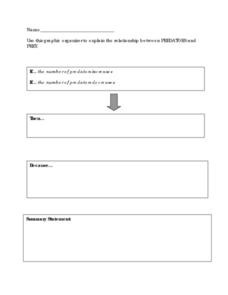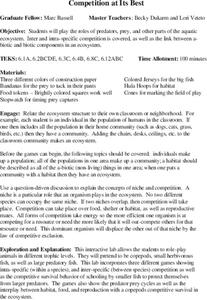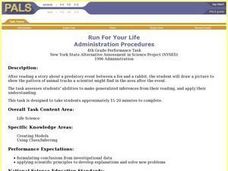Curated OER
Predator and Prey Game
Pupils explore the why the balance among producers, predators and prey is necessary in order for an ecosystem to be sustained over time. Through web games and activities, they discover how each component of the food chain works to...
Curated OER
Predators and Prey
Students explain how the food chain works. They contrast predators with prey and describe their function in nature. Students discuss how the food chain aids in keeping nature balanced. In small groups, they play a game that simulates the...
Curated OER
Natural Selection
Students examine adaptation through a hands-on activity and determine how the gene pool can affect adaptability. They simulate a predator and prey relationship by going on a hunt for colored acetate disks. After a three minute hunt, they...
Curated OER
Species Interactions
Eighth graders explore seven terrestrial biomes. They compare relationships between children, parents and friends to interactions among species. After observing pictures of types of interaction, 8th graders describe the predator-prey...
Curated OER
What's For Dinner?
Students explore the food chain. They brainstorm and create a consumer-consumed food chains using magazine pictures and research materials. Students identify consumer-consumed relationships.
Curated OER
redator and Prey- Food chain relationships
Students s identify the different trophic levels in the food chain and understand the importance of the energy cycle. They create a class food web using index cards and yarn and play a predator/prey game.
Curated OER
Birds of Prey
Students research various birds of prey on internet by following a worksheet with specific questions. Students answer questions on worksheet and write short response after completing research.
Curated OER
Bearly Any Ice
Students participate in a prey-predator game. After reading background information, they discover the impact from the changes global warming presents to the polar bears and ringed seals. They role play the role of either the seal or...
Curated OER
The Predator-Prey Simulation
Students play a game in which they simulate the interactions between a predator, lynx, and a prey, rabbit. Students collect data on the interactions, graph data, and make predictions for populations of several more generations.
Curated OER
Populations and Ecosystems
Sixth graders define terms prey, predator, and scavenger, describe predator-prey relationship, discuss effects of a lack of predators in an environment, and separate the role of the scavenger from that of the predator.
Curated OER
Who's Coming to Dinner?
Students identify the role predators/prey play in food chains, differentiate between food chains and webs, identify factors that affect the balance in food webs, and propose solutions to protect endangered species' environments and...
Curated OER
What Makes up an Ecosystem?
Eighth graders design posters of working ecosystems using pictures from magazines. They label autotrophic, heterotropic, or saprotrophic energy sources, and identify predators and prey.
Curated OER
Predator-Prey Relationships
Students understand ecological systems. They provide experiences to assist citizens to increase their sensitivity and stewardship for the environment.
Curated OER
Animals Abound
Learners explore the world of mammals, birds, and fish to compare and contrast their habitats, adaptations, and camouflages. Through research, musical experiences, and hands-on activities, the lives and adventures of these animals are...
Curated OER
Predator-Prey Simulation
Learners simulate the interactions between a predator population of lynx and a prey population of rabbits. They collect and graph the data, then extend the graph to predict the populations for several more generations.
Curated OER
Laws of the Jungle
Middle schoolers build a video game on predator-prey relationship. For this biology lesson, students identify the variables that affect this relationship. They write a short description and play each other's game.
Curated OER
Mariposas
Students examine how animals use camouflage for survival. In this investigative lesson students define vocabulary words and see how it is the environment that controls which adaptations will help in survival.
Curated OER
Amusing Animal Adaptations
Students identify how animals adapt characteristics to help them survive or reproduce. In this animal instructional activity, students draw pictures of their animal and adaptation.
Curated OER
Infrared Zoo Lesson 2 Index Dinner in the Dark
Students discover how certain snakes can find prey using a natural infrared sensor. They think about small prey animals and how a pit viper snake finds them in the forest. Students explore the physical characteristics of the animals...
Curated OER
Dull Duck, Dashing Duck
Learners examine the different colors and patterns found on animals bodies, specifically birds. Through discussion, students discover the use of the colors and patterns for protection from predators and the advantages while hunting prey,...
Curated OER
Compettion at its Best
Sixth graders role play predators, prey and other parts of the aquatic ecosystem. They show inter and intra-specific competition as well as the link between abiotic and biotic components in an ecosystem. Students play games about the...
Curated OER
CSI Clamshell Investigation
Learners explore predator/prey relationships. They research information on moon snails and claims. Students draw conclusions from the data collected. They use math and graphing to determine if there is a relationship to the clam's size...
Curated OER
Run For Your Life
Pupils draw a picture of animal tracks a scientist might find after they read a story about a fox chasing a rabbit. They make up a key to represent the foxes' tracks and the rabbit's tracks.
Curated OER
Predator Prey Population Links
Fifth graders relate population of animals to its available food supply. They participate in an experiment and gather information. They use the data to draw conclusions.

























